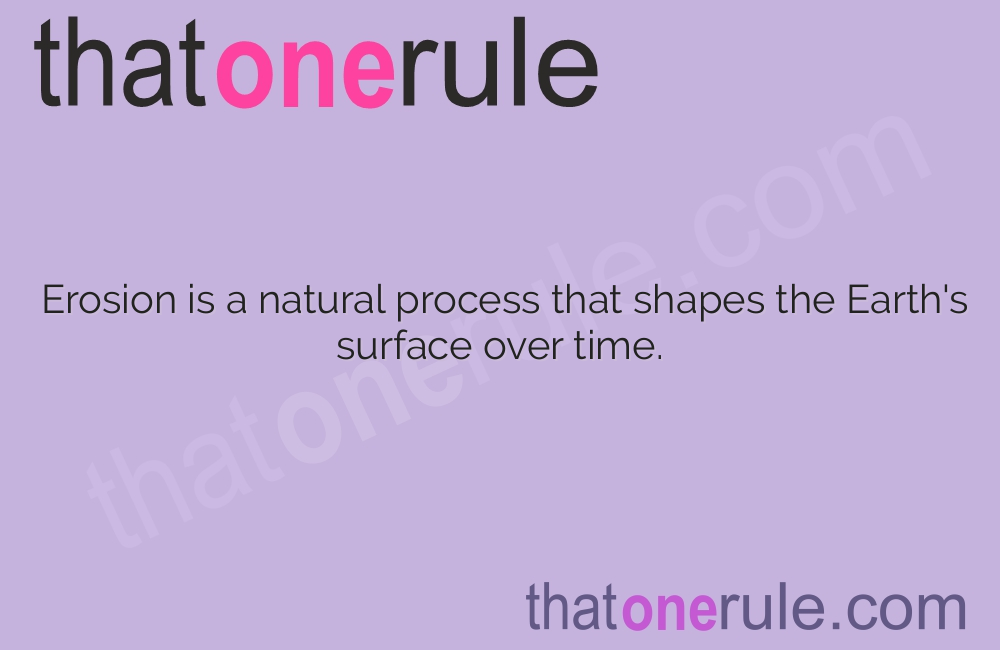Erosion Facts – Understanding the Force that Shapes our Landscapes

Erosion is a natural process that shapes the Earth’s surface over time.
Wind erosion occurs when strong gusts of wind carry away loose soil and sand particles.
Water erosion is caused by the movement of water, which can carve out valleys and riverbeds.
Erosion can significantly alter landscapes and even create new formations, such as arches and canyons.
The Grand Canyon in the United States is a remarkable example of the power of erosion over millions of years.
Coastal erosion is a major concern for many communities, as it can lead to the loss of land and property.
Soil erosion can be minimized by implementing conservation practices like terracing and contour farming.
Erosion can uncover fossils and artifacts, providing valuable insights into Earth’s history.
The erosion of rock formations can create unique and dramatic shapes, like the famous Twelve Apostles in Australia.
Erosion can lead to the formation of sedimentary rocks, such as sandstone and shale.
The erosion of glaciers can carve out fjords and shape mountain ranges.
Erosion is a slow process, but its cumulative effects can be profound.
Human activities, such as deforestation and construction, can accelerate erosion rates.
Erosion can cause landslides and mudslides, posing significant risks to human lives and infrastructure.
The Great Barrier Reef in Australia is threatened by coral erosion due to rising ocean temperatures.
Erosion Facts – Understanding the Force that Shapes our Landscapes part 2
Erosion creates opportunities for the formation of fertile soil, which is crucial for agriculture.
Ancient civilizations, like the Mayans, developed sophisticated irrigation systems to prevent soil erosion and maintain agricultural productivity.
Erosion can alter river channels, contributing to flooding or decreasing water availability.
Wind erosion can result in the formation of large sand dunes, like those found in the Sahara Desert.
Erosion is an ongoing battle between nature and mankind, requiring careful land management and conservation efforts.
Coastal erosion can damage ecosystems and negatively impact marine life.
Islands can be formed or eroded away over time due to the forces of erosion.
Erosion can expose different layers of rock, providing geologists with valuable information about Earth’s geological history.
Erosion can reveal hidden treasures, such as precious gemstones or minerals.
With advanced technology, scientists can now simulate erosion processes to better understand their impact.
Erosion can lead to the loss of valuable topsoil, affecting agricultural productivity.
The erosion of cliffs can endanger coastal habitats and nesting sites for birds.
Erosion can cause the collapse of structures built on unstable ground, like buildings or bridges.
Erosion can create natural artworks, like stone arches and balancing rocks that attract tourists from around the world.
The erosion of river banks can alter water flow, impacting ecosystems downstream.
Erosion can be managed by planting trees and vegetation, which stabilize the soil and prevent erosion.
Overgrazing by livestock can contribute to erosion by removing protective vegetation cover.
Erosion is an essential process for the formation of soil and the recycling of nutrients.
Erosion can reveal unique geological features, like fossilized footprints of ancient animals.
Erosion can expose underground water sources, contributing to the replenishment of aquifers.
The erosion of cliffs along coastlines can result in the formation of sea stacks and caves.
Erosion is a natural part of the rock cycle, which includes weathering, erosion, and deposition.
Erosion can lead to the destruction of cultural heritage sites, erasing important historical information.
The erosion of riverbanks can contribute to the contamination of water by exposing pollutants.
Erosion can alter river systems and create new paths, affecting navigation and commerce.
The erosion of sand dunes on beaches can lead to beach erosion, threatening tourism and coastal communities.
Erosion can expose valuable minerals and metals, attracting mining activities.
Erosion can contribute to the formation of caves and underground rivers.
The erosion of volcanic ash can create fertile soil, leading to lush vegetation and agricultural abundance.
Erosion reminds us of the ever-changing nature of our planet and the need for sustainable land management practices.

